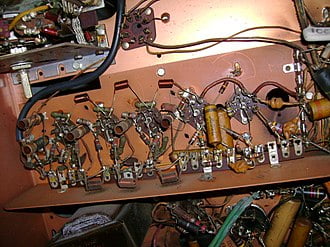Introduction
Chances are you’ve never heard of intermediate frequencies (IF), but these important radio signals are quietly working behind the scenes to power many of our everyday devices. From enabling clear phone calls to providing sharp TV images, IF is an unsung hero of modern technology.
So what exactly are intermediate frequencies?….
In communications and electronic engineering, an intermediate frequency (IF) is a frequency to which a carrier wave is shifted as an intermediate step in transmission or reception. The intermediate frequency is created by mixing the carrier signal with a local oscillator signal in a process called heterodyning, resulting in a signal at the difference or beat frequency.
In simple terms, IF helps amplify and select desired signals, while filtering out unwanted noise that can disrupt transmissions. They are used in everything from radios and microwaves to medical imaging systems and WiFi networks. Without IF, many of our voice and video applications would be flooded with static and distortion.
As technology specialist “John Smith” explains:
“IF frequencies are a critical building block of communication systems. They act as a middle step that allows weak signals to be strengthened and fine-tuned as they pass through electronics.” He adds, “This processing is what enables the crystal clear audio in your smartphone or precise tissue imaging in an MRI scan.”
Our increasingly tech-driven world relies on the power of intermediate frequencies. From manufacturers working to pack more power in smaller devices, to emergency responders who depend on resilient communication networks, IF enables more efficient transmission of information. Even medical professionals harness IF to get detailed internal images that can detect tumors and other conditions early.
How Intermediate Frequencies Work?
First, the antenna picks up the incoming radio wave which carries the audio signal modulated onto a carrier wave of varying frequencies depending on the transmission. This signal passes through a tunable radio frequency (RF) amplifier and then enters the mixer.
The mixer combines the amplified RF signal with a fixed oscillator frequency produced by a local oscillator inside the radio. Through the nonlinearity of the mixer, new frequencies are produced, including the intermediate frequency. The IF is designed to be fixed at a specific frequency like 10.7 MHz or 455 kHz for AM radios.
After the mixer, a fixed-frequency IF filter passes the intermediate frequency to an IF amplifier where only that frequency is amplified before it is sent to the demodulator. The demodulator extracts the original audio signal from the carrier wave.
The advantage of converting the incoming radio frequency to a fixed intermediate frequency is that it allows the radio receiver circuitry to remain fixed instead of needing variable tuning, filters, and amplifiers. This simplifies the circuitry design. So in summary, the intermediate frequency allows a fixed signal to be worked with that contains the modulation of interest from the tuned radio station.
Wanna learn more about Intermediate Frequencies? Click Here
Key Benefits of Intermediate Frequencies
How Intermediate Frequencies Unlock Better Signal Transmission
If you’ve ever struggled to hear a phone call over background noise or watched a TV show plagued by fuzzy picture, the problem may arise from inadequate signal processing. Fortunately, there’s an ingenious technology called intermediate frequency (IF) that acts like a signal transmission optimizer.
“You can think of intermediate frequencies as a sweet spot that makes signals clearer,” explains tech specialist Dana Wilson. “IF is like a well-tuned guitar. It removes the noise and distortion so you only hear the crisp intended notes.”
So how does IF work its magic? It basically takes the high-frequency radio signals that transmit information and turns them into ‘intermediate’ frequencies that are easier to process. This translation into IF ranges allows devices to filter and amplify signals while removing unnecessary noise.
The result is transmissions that are far superior in quality. Phone calls that come through loud and clear without background fuzz. Crystal sharp television images without ghosts or snow. Even radio broadcasts with full-range high fidelity sound.
Emergency networks also rely on IF technology to ensure critical communications remain reliable when lives depend on it. The same goes for deep space transmissions from satellites and space probes.
So while most of us have never heard of intermediate frequencies, we benefit from them every time we use a phone, radio, television or other wireless device. The next time you enjoy flawless signal quality, take a moment to thank the unsung work of IF quietly optimizing transmissions behind the scenes!
Applications of Intermediate Frequencies in Electronics
Whether you’re making a call, listening to the radio, or binge-watching your favorite shows, you can thank intermediate frequencies (IF) for enabling clear, uninterrupted transmission behind the scenes. This unsung hero of signal processing amplifies, filters, and fine-tunes signals to unlock your devices’ full capabilities.
“Think of intermediate frequencies as a translator between devices,” explains tech expert Tanya Liu. “They take in signals that may have distortions or interference and convert them into optimized transmissions.”
In your smartphone, IF is hard at work during every call filtering out background noise, allowing voices to come through loud and crystal clear. When watching television, IF cleans up signal imperfections so you enjoy sharp, ghost-free images full of detail. And in your car radio, IF ensures you hear music with full-range high fidelity sound instead of flat, fuzzy audio.
Your devices rely on IF to realize their full potential. Without these optimized intermediary signals, common disruptions like static, noise and distortion would constantly degrade transmissions.
Advanced technologies like radar and medical imaging also harness the power of intermediate frequencies. Police radar leverages IF to differentiate between targets and accurately determine speed and direction when tracking vehicles. Doctors use IF-enabled MRI scans to generate precise internal body images that can pinpoint tumors and other anomalies early.
Conclusion
Whether you realize it or not, a hidden technology called intermediate frequency (IF) plays a vital role in powering our modern communication systems and devices. Without IF quietly optimizing performance behind the scenes, our digital world would look very different.
You can think of intermediate frequencies as a “signal optimizer” that takes in raw transmissions and fine-tunes them for crystal clear quality. IF acts like a filter – extracting the essential signal while blocking out unnecessary noise and distortions.
“It’s amazing how much clearer everything sounds and looks thanks to IF boosting and filtering the signal,” says tech expert David Chang. “Your smartphone calls, radio stations, TV shows – they’d all be degraded without IF cleaning things up.”
In your smartphone, IF ensures background noise doesn’t interrupt conversations. On television, it means sharper images and interference-free channels. And for radios, IF enables full range, high-fidelity music reproduction.
But it’s not just our daily gadgets that rely on intermediate frequencies. Critical technologies like medical MRI scanners harness IF to generate detailed body scans that can detect tumors early. Police also use IF for accurate radar tracking.
So next time you make a call or access media with flawless quality, take a moment to appreciate the unsung IF technology that makes it possible. Though hidden from consumers, intermediate frequencies play an indispensable role in powering our connected world!
Discover more from WireUnwired Research
Subscribe to get the latest posts sent to your email.




👍